And so, I've decided to get in on the game myself, reviewing a set of books I'm sure are rather under-exposed: get ready for Vintage Creationist Dinosaur Art! As a dinosaur nut from a Young Earth Creationist background, I grew up with many books with such provocative titles as "Noah's Ark and the Lost World". They've been gathering dust on my shelves for a while, so when I recently leafed through them a while back, I got the bright idea to give them the Love In The Time Of Chasmosaurs treatment. Now, since I hope to appeal to both sides of the aisle with this series, I'm going to avoid any assessment of the larger models of creationism or evolutionary theory; I am endeavoring to strictly evaluate the reconstructions and portrayals of the creatures in these books, and maybe increase awareness of the aforementioned in the process.
With that in mind, let's move on to the oldest book in my collection. Straight out of 1977, it's Dinosaurs: Those Terrible Lizards!!!
 |
| ROAR! |
We begin unassumingly enough with a pair of dinosaur skeletons, which appear to represent Tyrannosaurus and Corythosaurus, respectively. It's kinda hard to screw up a skeleton unless you're just making things up on the fly, and happily, the illusatrator (a one Marvin Ross) has rendered these reasonably well for their time. The neural spines on the Corythosaurus' vertebrae should be a little taller, and while Mr. Ross appears to be aware of the existence of gastralia (stomach ribs) on the T-rex, they are far too thick (they should be much thinner than the normal ribs, and connecting to a sort of sternum). The poses are rather outdated of course, but as all the dinosaurs in this book remain ponderous tail draggers, we won't dwell too much on this topic.
Being written by creationists, the book starts off with brief explanations of the theories of evolution and creation. I won't dwell on them here, but this visual representation of evolution certainly stands out. I like the way the artist made the dinosaurs all blend together in a manner suggesting a common source.
 | ||
| It stands opposite another image with all the dinosaurs standing perfectly separate but not doing anything particularly interesting, so in the interest of space I only included this one. |
The next illustration features a hallmark of early creationist arguments that has since been abandoned by most mainstream creation societies: the Paluxy River dinosaur tracks. These famous trackways are significant for showing what seems to be three theropods (carnivorous dinosaurs) following a small herd of sauropods (long-necks). During the 1930's, the claim began spreading around that human footprints could be seen interspersed with the dinosaur trackways, thus proving human coexistence with dinosaurs. However, since that time, some of the purported human footprints have turned out to be outright forgeries, while others have been proven to be badly eroded dinosaur footprints. It makes for a provocative illustration, though! Speaking of which, the art in this book alternates between not-unpleasant watercolor paintings and what I believe to be green pencil drawings, though I'm not sure about the latter. Art majors, feel free to correct me!
 |
| I believe it's meant to represent a Ceratosaurus. |
Every creationist book on dinosaurs has some variation of this next image, because how could you not? Basically, it quotes a passage from the Job 40 that talks about the Behemoth, the mightiest of all land animals. All the creationist books I owned drew explicit comparisons between it and the sauropod family of dinosaurs. If you're coming from a creationist background, it's a very convincing argument. Like the book says, one could argue that it's talking about an elephant, though one would have to explain the verse about a "tail that sways like a cedar". Speaking of which, Mr. Ross includes an elephant here, which is given a shaggy coat of fur with no particular explanation. It bears a greater resemblance to an Asian Elephant than a Wooly Mammoth, though I wonder if this represents an early appearance of the creationist idea of created "kinds"? It would explain this creature's blended appearance, though no such reasoning is given in the text.
 |
| Behemothus biblicus |
 |
| The Mysterious Wooly Elephant |
The next picture portrays a general Mesozoic menagerie, though I'm not sure what's up with that duck-billed sauropod in the background. We'll give Mr. Ross the benefit of the doubt and say it's a prescient depiction of the eventual discovery of Nigersaurus. And near the middle, we have the tree-climbing Hypsilophodon meme! At least I assume that's a Hypsilophodon, since it literally could not be any more of a "generic-small-dinosaur". Also, sad Triceratops is sad. I want to give him a hug. Perhaps the other kids made fun of his JP-Dilophosaurus frill.
 |
| Also, classic pancake-Ankylosaurus makes several appearances in this book. |
Now it's time for "Don't Mess With Armoured Dinosaurs", the PSA! We are treated to several scenes of well-endowed herbivores giving the mean old sharp-teeth a piece of their minds. Or horns. Whatever.
 |
| Queen Elizabeth the Third-Horned watches her loyal subject gore a vicious T-rex to death. He was probably a filthy Spaniard, anyway. |
 |
| FSHWING! |
 |
| I would seriously advise against any plan that in any way involves Turtle-Tank Ankylosaurus. |
I thought for sure this next image was more or less copied from some other source, but it seems to be more original than many vintage dinosaur books tend to be, since it doesn't seem to explicitly copy any pre-existing painting I can find, unless maybe it's the middle Trachodon in this piece by Zdeněk Burian. Incidentally, the genus "Trachodon" has since slipped into the territory of "nomen dubium", and the title of "generic duck-billed dinosaur" has since passed on to Anatosaurus and then Edmontosaurus, successively. The "duck-billed" hadrosaurs are no longer thought to have been aquatic either. Other than that, the illustration is pretty good for its time, especially in its depiction of hadrosaurs as being capable of both bipedal and quadrupedal movement.
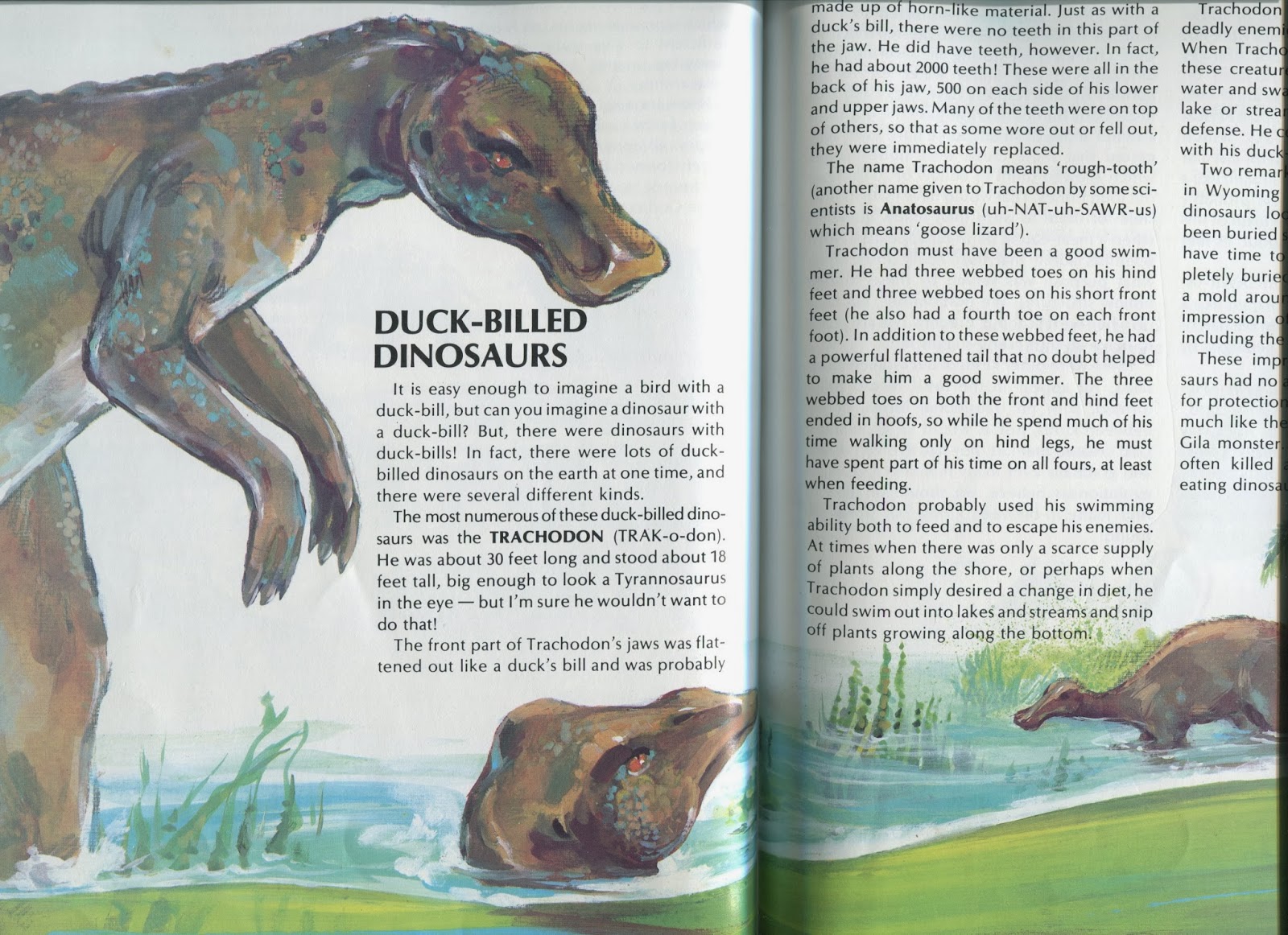 |
| I do rather like this picture, though. |
This next image is a little odd in its choice of dinosaurs, as they really should have appeared back a few pages ago. Psittacosaurus actually belongs with Triceratops and Styracosaurus (which I forgot to scan), as it hails from Ceratopsia, the family of horned dinosaurs (despite its lack of such ornaments). Pachycephalosaurus is distantly, distantly related to the Ceratopsians, and so would have been better to showcase earlier as well. Hey, at least they managed to get the distant relation between Ankylosaurus and Stegosaurus right! Also, the description of Pachycephalosaurus reeeally reminds you of how repetitive this book can be at times.
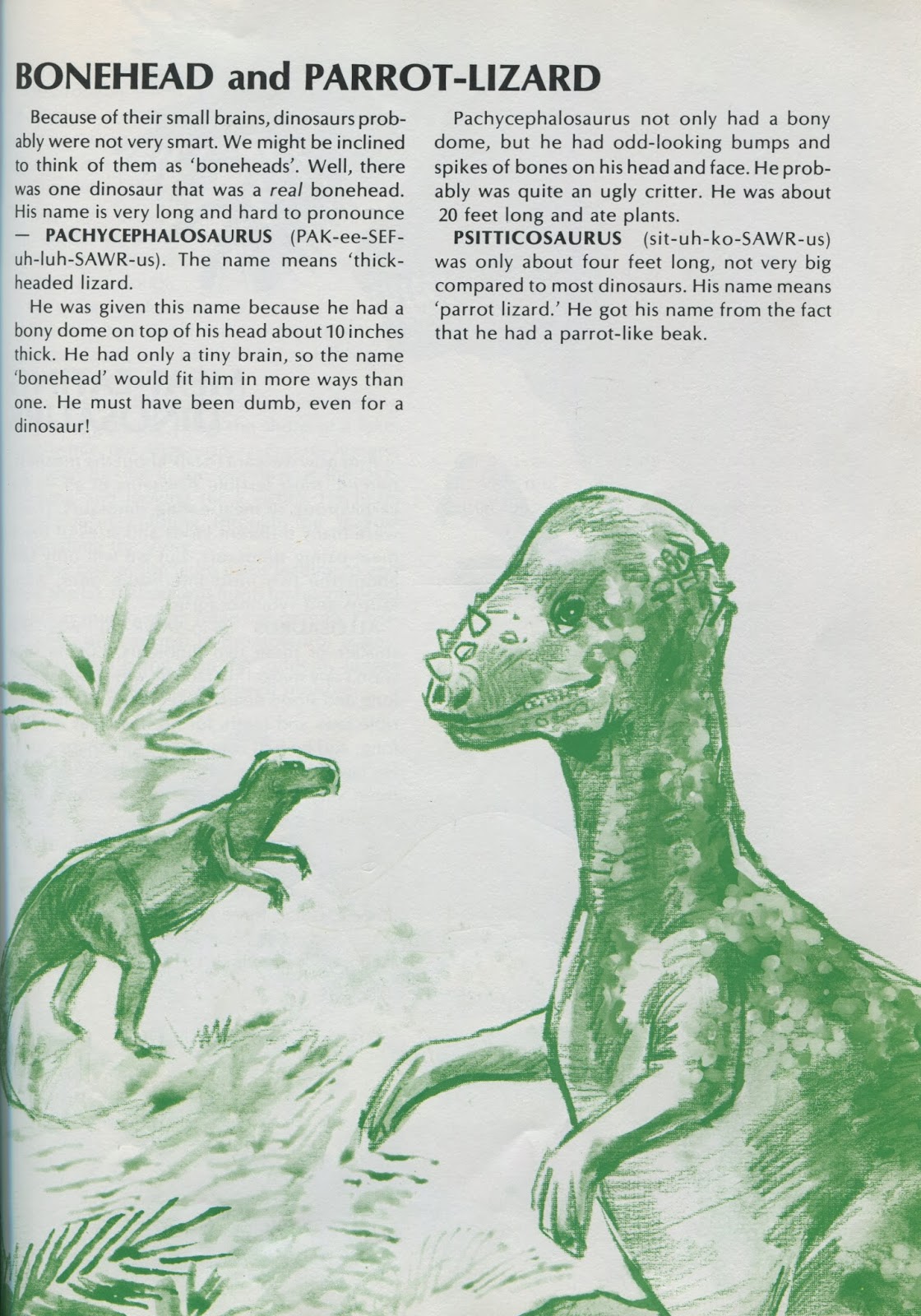 |
| This boneheaded bonehead boneheadedly boneheaded his way into the Bonehead Club. He was a real bonehead. |
Now we get to the part all little kids wait for: the Meat-Eating Dinosaurs! The book chooses to focus only on "the two most interesting ones" (I would beg to differ), leading off with a rather triangle-faced Allosaurus contemplating a classically swamp-bound herd of sauropods. A rather common problem plaguing old paleoart is the scourge of the generic-o-pod, where unique, interesting features are obscured by artists simply paving them over in favor of easier-to-draw profiles. Thus, many kids (like me) grew up not realizing Allosaurus actually had admittedly small but still quite distinctive crests that really make it stand out next to the larger, supposedly cooler T-rex. Such is the case here.
 |
| "Ah! I am really enjoying this peaceful, introspective moment!" |
But what's this? Could Murder-Death-Kill Allosaurus have suddenly sprouted some lacrimal crests? It's hard to tell even with the book here in front of me, but it definitely looks like it has some little ridges on the sides of its still-misshapen head. YOUR PUNY BRONTOSAURUS IS NO MATCH FOR AWESOME-BRO ALLOSAURUS.
 |
| "LOL JK, I KEEL U NOW" |
Another well-known old paleoart curse is that nobody can ever quite seem to get the arms right on Tyrannosaurus rex. Here they seem to be sprouting from his jugular veins. Old Rexy gets no murder-death-kill scene of his own, having presumably used up his allotted screen-time getting stabbed and bashed by armored herbivores several pages ago.
 |
| "That looks pretty good. Coming out of the back of his neck there..." |
Next up we get to the mighty long-necked sauropods! We start off we a majestic portrait of... an oblivious sauropod having his tail bitten off. There's this old idea that dinosaur brains were so small, and their bodies so long, that they wouldn't have been able to process any signals coming from or going to the back half of their body, so they needed a "second brain" in their hips to help share the load. This has long since been disproven, but still pops up today, mostly famously in connection to Stegosaurus, though here we see it being demonstrated on an unsuspecting, tail-dragging Diplodocus (it was also referenced in the recent hit movie Pacific Rim). See this blog post over at Sauropod Vertebra Picture of the Week for further discussion of this idea. At least it's not slogging through a swamp as they were normally depicted!
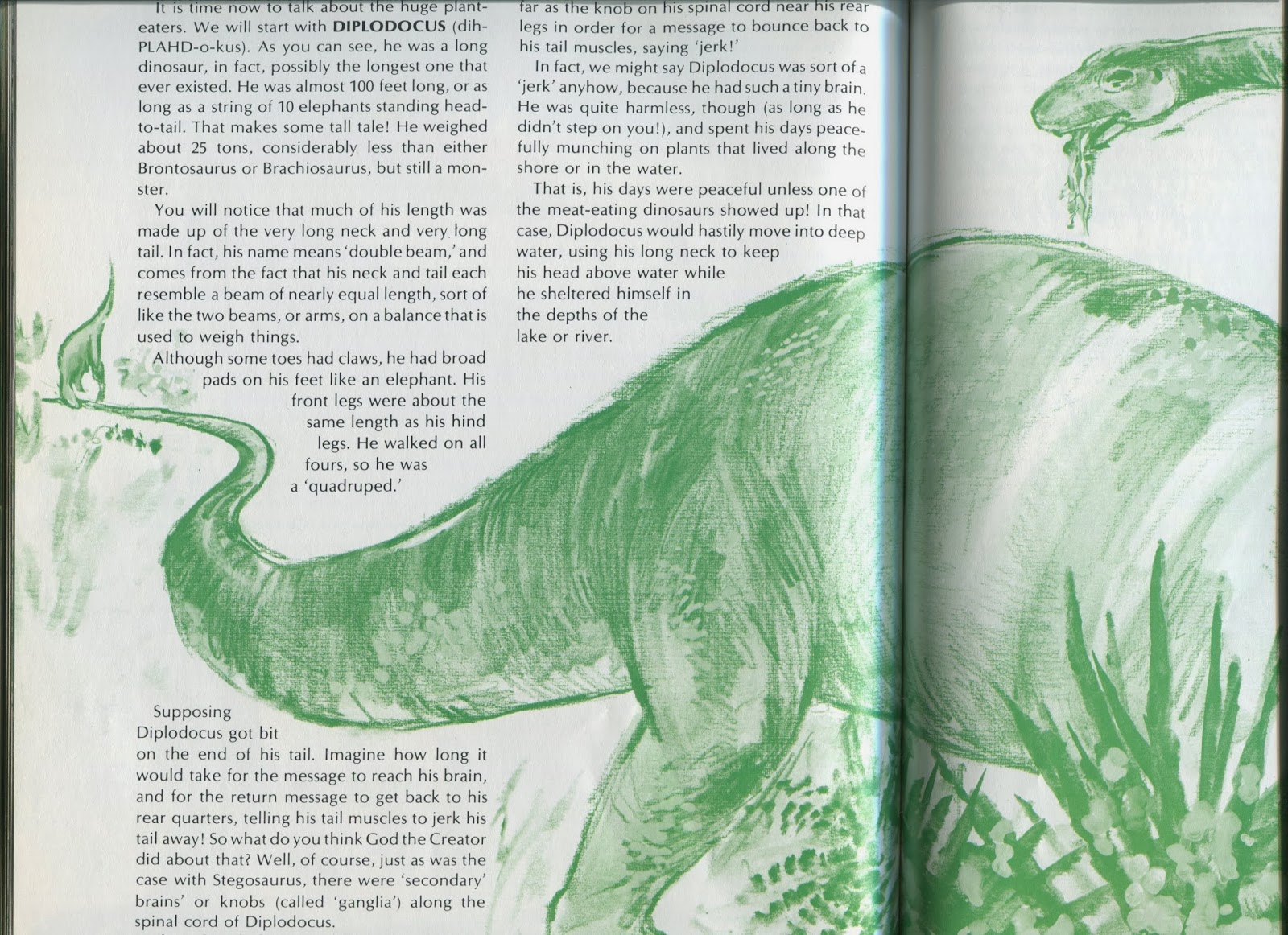 |
| "Duh, what?" |
We also get a star appearance by the great Brontosaurus! What's that? It's been Apatosaurus nearly a century now? Eh, it's okay. The book pays lip service to that, so they can go right back to calling it Brontosaurus. We also get a reappearance of the Paluxy human-dinosaur meme as a bonus.
 |
| That kid looks for all the world like he accidentally wandered in from an old-timey children's book on David and Goliath. |
Old Bronty of course spends all his time wading around in swamps, as do these somewhat Burian-inspired Brachiosaurs (with another nod to the secondary brain meme). The text states that its nostrils were positioned on top of its head, like a submarine we are informed, so that it could hide underwater from predators. Sauropods, Brachiosaurus especially, are now thought to have been so tall that the water pressure would have rendered them unable to expand their lungs should they have actually tried this strategy in real life, suggesting that they did not make a habit of setting up shop in deep water.
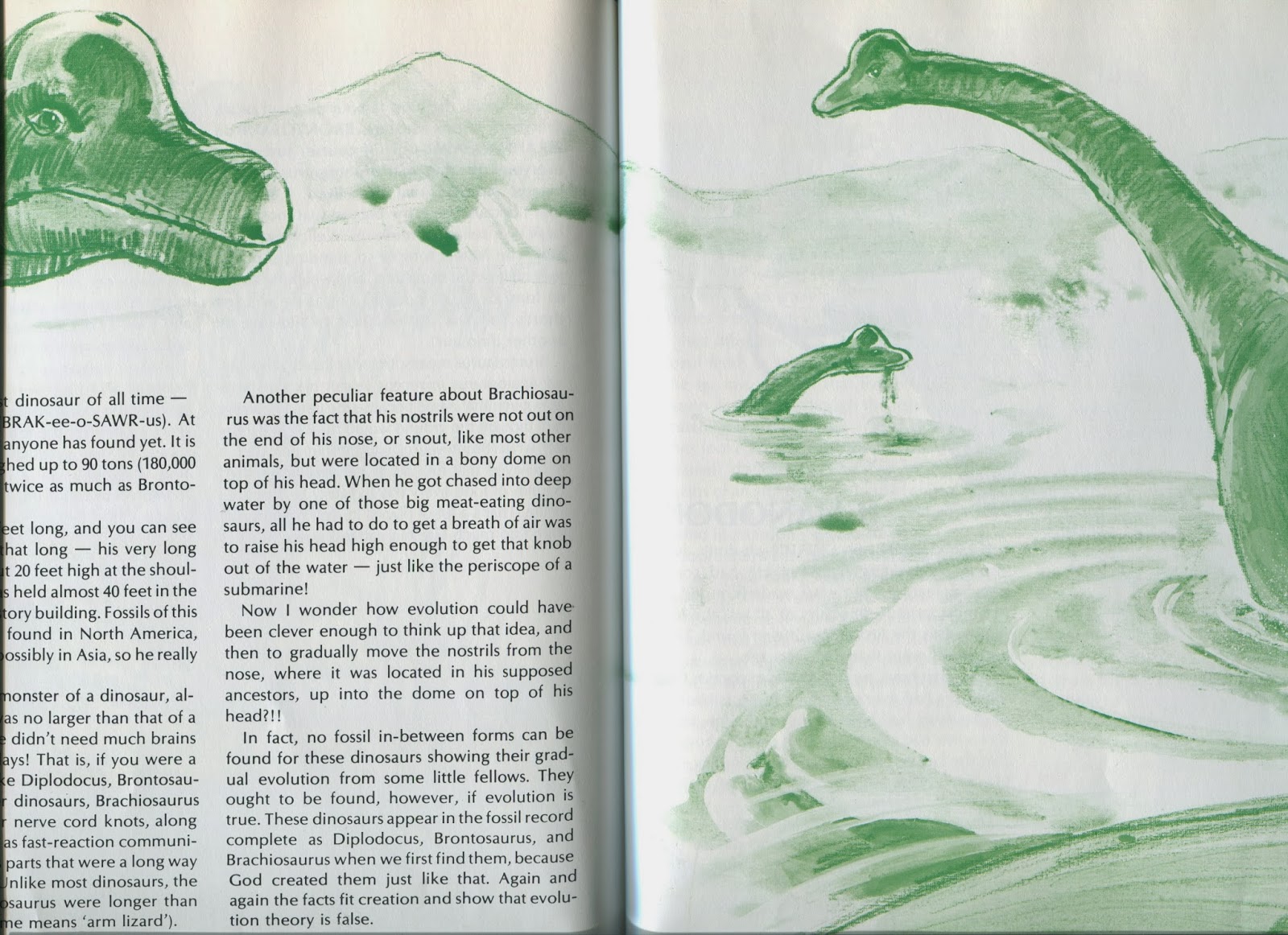 |
| "The order ish, engage the shilent drive!" |
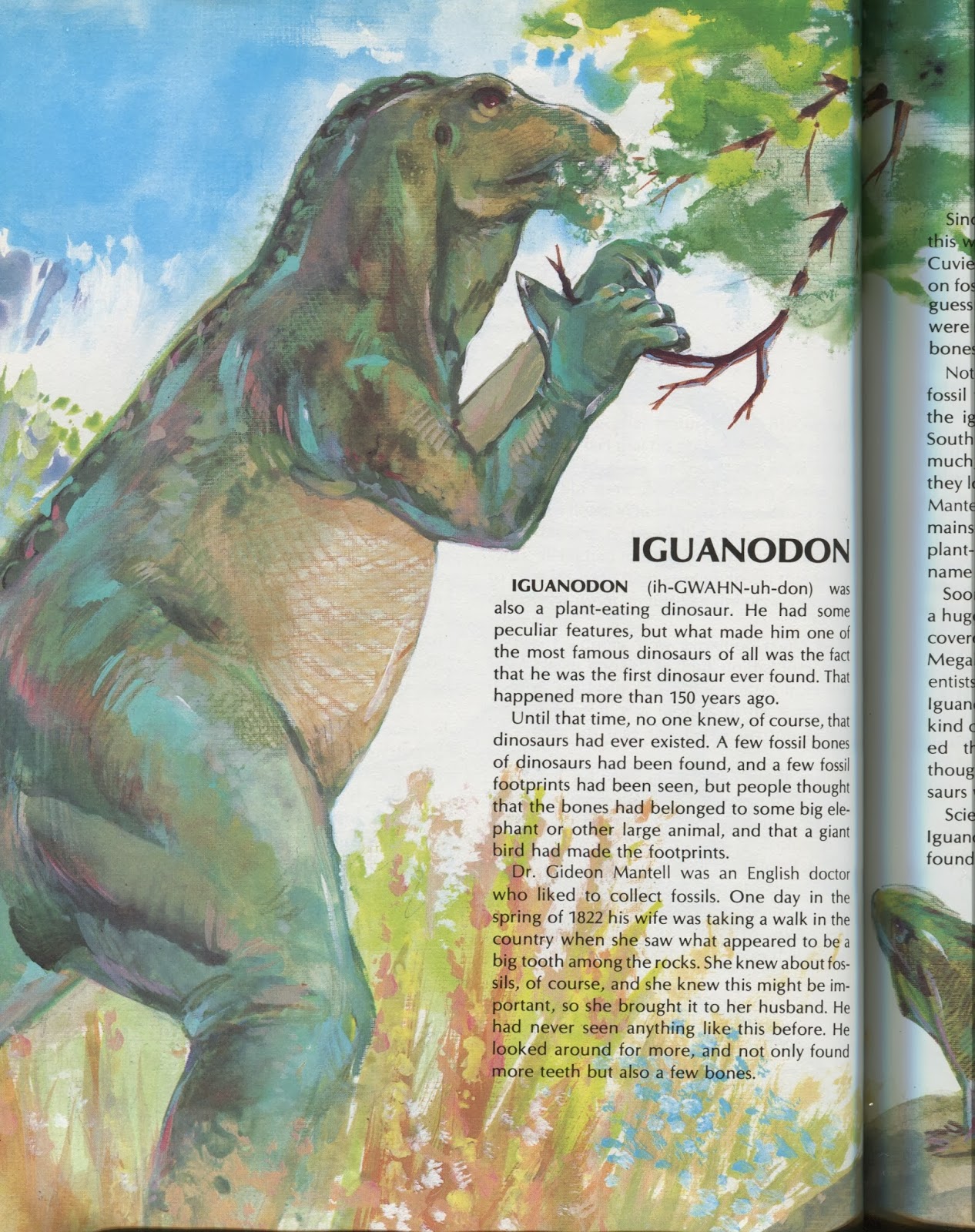 |
| My scanner cut most of it off, but I love the little Iguana in the corner giving Iguanodon it the most adorable little brother look it can muster. |
Did I mention Generic-o-pods earlier? Sorry, that was somewhat unfair. HERE we see a group truly indistinguishably illustrated dinosaurs, identifiable only by the vaguest of references in the text. I'm guessing the one eating the lizard is Struthiomimus, since the text describes it as doing such, which maybe means the one next to it is Ornithomimus? The two in the middle are likely meant to be Comsognathus and Podokesaurus, though the perspective in the picture is such that their apparent small size may be misleading, and all four previously mentioned dinosaurs may in fact be interchangeable! We can be fairly certain the one on right right is meant to represent Oviraptor, however, caught red-handed in the act of stealing an egg, though we'd have no way of knowing otherwise since it's lacking its distinctive head crest. (This fact, among others, leads me to believe this book may have been an inspiration for much of the artwork here.) Oviraptor originally gained its reputation as an egg thief when it was discovered buried with a nest, apparently buried in the act of robbing the cradle. Later, CT scans revealed that the babies in side the eggs were in fact little Oviraptors themselves, meaning the adult was actually the mother, which, when you think about it, you have to wonder how that was not the initial conclusion in the first place. They text also mentions that though they look a bit like ostriches or chickens, they would have had leathery skin instead of feathers. We now know the opposite to be true. I should add that no matter what your orientation on creation vs evolution, there really is no question about whether certain dinosaurs had feathers. They did; though you don't have to take that as proof that they evolved into birds any more than fish evolved into reptiles because they both have scales. See my other blog post for more on this.
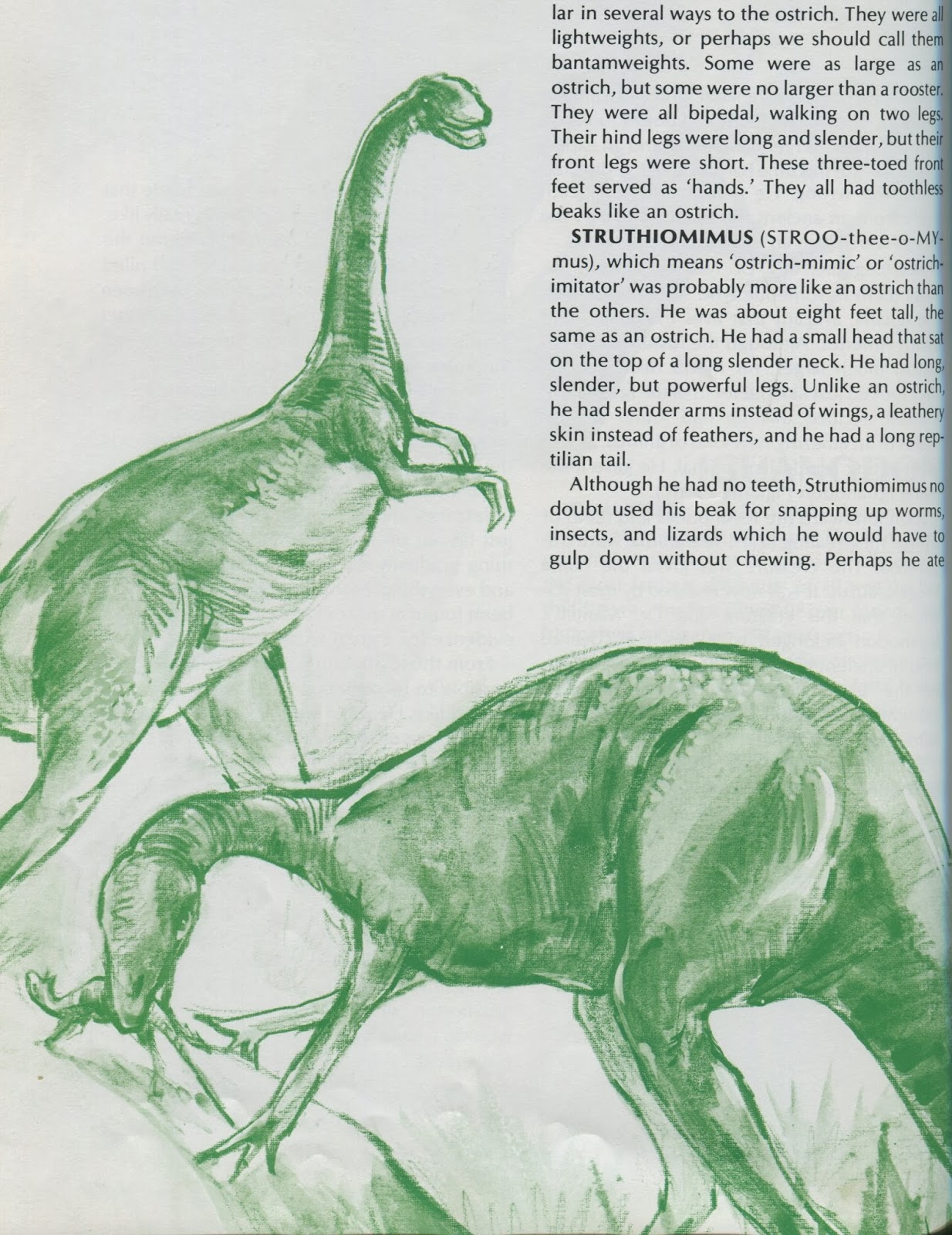 |
| Struthiomimus and Ornithomimus, probably. |
 |
| Probably Compsognathus and Podokesaurus, definitely Oviraptor. |
I hope nobody has been misinterpreting any jokes I've made as ragging on this book at all; this has actually all been fond memories so far. Unfortunately, we now come to an illustration that I am rather angry about these days.
It purports to disprove the evolutionary theory that dinosaurs evolved into birds by pointing out that birds are thought to have arisen among the Saurischian ("lizard-hipped") dinosaurs rather than the Ornithschian ("bird-hipped") dinosaurs. However, Deinonychus, the raptor dinosaur that got the whole birds-are-dinosaurs movement going, HAS BIRD-LIKE HIPS, despite otherwise clearly belonging to the Saurischian family. In fact, these bird-like hips are one of the biggest reasons its discoverer suggested the bird connection in the first place.
I really don't think I can make any excuse for the author here, because if they knew about the Bird-o-saur theory, they should have known about Deinonychus. At best, the benefit of the doubt grants them only inexcusable ignorance about the claims they're making. This Saurischian vs. Ornisthschian line stuck around much longer than it should have as well, as we shall see in a future post.
I don't want to dwell much more on this. There are decent reasons to dispute the idea that dinosaurs evolved into birds, but hips are not among them. Let this be a plea for honesty and fact-checking lest you drive away the very people you're attempting to reach. After all, how do you think I felt when I realized I had made it to 24 years old not realizing the misleading nature of this image?
 |
| Sigh. I promise I'm done now. |
But enough of that. Let's turn our attention back to more light-hearted matters. This next image is laughably wrong, but in a much more constructive way. The function of the head crests in many species of duck-billed hadrosaurs often found itself the topic of discussion among paleontologists back in the day. Similar to the periscoping Brachiosaurs from earlier, one early idea stated that perhaps dinosaurs like Parasaurolophus used their crests as snorkels to breathe while hiding from predators underwater. I would hazard a guess that this, combined with their distinctive snouts, is the reason why hadrosaurs were so consistently depicted as swimmers, despite the fact that the absence of air holes in the crests quickly disproved the snorkeling theory. The mystery appeared solved when an experimenter made a cast of the nasal passages in the crest and blew air through them, producing a trumpet-like sound, leading to the now generally accepted theory that hadrosaurs used their crests to amplify their voices. Our delightful little book here has other ideas however. BEHOLD, THE MIGHTY FIRE-BREATHING PARASAUROLOPHUS!!!
 |
| FWOOSH! |
I love this image (which ended up becoming a persistent creationist meme, as we'll see in later books), and always found it rather inspiring as a child. I imagine everyone can see the appeal in the idea that dragon legends were inspired by relict populations of dinosaurs. The book spends a weird amount of energy explaining this idea, too. Seriously: it devotes six whole pages to this one idea, two of which are nearly all text! In a children's book! No other concept in this tome receives such detailed treatment. And sadly for Parasaurolophus draconis up there, it has zero anatomical basis. Oh sure, a similar phenomenon exists among the Bombardier Beetles, as the book wastes plenty of time pointing out, but nothing about hadrosaur skeletal anatomy suggests such a feature. The nasal passages are just that: long straight airways from the nose to the back of the throat. No side chambers for the storing or mixing of volatile chemicals. Even if such structures existed as soft-tissue features in the throat, the chemicals or fumes would have to travel through the entire length of the crest in order to be expelled onto the intended target. This would leave precious little time for other things, like, oh, I don't know, breathing. Such a feature would be much more likely on an otherwise much more "generic" or "boring" dinosaur, one which we would likely never suspect based on only dry bones. Still, it's a nice idea.
 |
| Plus this Bombardier Beetle cartoon is kinda funny, I guess. |
After that, it's on to the obligatory denouement of all dinosaur books: why did those grand old reptiles ever go extinct? The answer provided by this book is of course the Great Flood, AKA Noah's Flood. While dinosaurs are suggested to have been on Noah's Ark, the book speculates the subsequent Ice Age would have killed them all off. There's a sparse bit of impressionistic landscape artwork that I didn't feel like scanning, although there was a decent looking Chasmosaurus skull in one of them. Oh well. I'm feeling too lazy to do it now. In any case, we close with this final image, comforting us with the idea that perhaps maybe we should be glad that dinosaurs no longer live among us after all.
 |
| Um, what?!? I BEG TO DIFFER. |
Anyway, thank you so much for reading! Please comment below if you have any questions about anything, even if it wasn't necessarily in the book. I know you'll all keep a civil tongue. ;)
UPDATE (11/18/2015):
I have a new blog now titled Stuckasaurus, where I've recently review the 1992 "reboot" of this book titledDinosaurs by Design. Click for Part 1 and Part 2. Give it a look!
